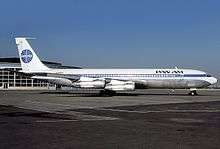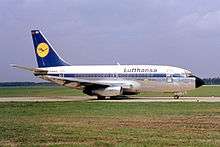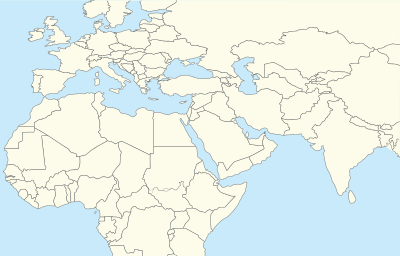1973 Rome airport attacks and hijacking
| 1973 Rome airport attacks | |
|---|---|
|
Initial attack site at Leonardo da Vinci–Fiumicino International Airport in Rome and hijacked airliner landing sites | |
| Location | |
| Coordinates | 41°48′01″N 12°14′20″E / 41.80028°N 12.23889°ECoordinates: 41°48′01″N 12°14′20″E / 41.80028°N 12.23889°E |
| Date | 17 December 1973–18 December 1973 (CET / UTC+01:00) |
| Target | Aircraft in Leonardo da Vinci–Fiumicino Airport |
Attack type | Terrorism, aircraft hijacking, hostage crisis, firebombing |
| Deaths | 34 |
Non-fatal injuries | At least 22 (including 1 terrorist) |
Suspected perpetrators | Black September and Palestine Liberation Organization (presumed)[1] |
The 1973 Rome airport attacks and hijacking were a set of Palestinian terrorist attacks originating at Leonardo da Vinci–Fiumicino International Airport in Rome, Italy, resulting in the deaths of 34 people.[2] The attacks began with an airport terminal invasion and hostage-taking, followed by the firebombing of Pan American World Airways Flight 110.
Pan Am Flight 110 was a scheduled Pan American World Airways flight from Rome, Italy to Tehran, Iran by way of Beirut, Lebanon. On 17 December 1973, shortly before takeoff, the airport terminal and the flight aircraft were invaded and the aircraft was set on fire by armed Palestinian gunmen, resulting in the deaths of thirty persons on the plane and two in the terminal.[1]
Following the aircraft invasion, the gunmen hijacked a Lufthansa airliner and killed two more people before being taken into custody by the State of Kuwait.[3]
Background
Since the ousting of the Palestine Liberation Organization (PLO) from Jordan, following the Jordanian-Palestinian civil war, the Palestinian military organizations made South Lebanon into its headquarters, enlisting militants from Palestinian refugee camps. South Lebanon was also referred to as Fatahland, due to the almost complete control of Fatah and other military Palestinian organizations over this officially Lebanese area, which they used to stage attacks against Israel, mainly targeting civilians, and to engage in international airflight terror campaign.
Terminal invasion and firebombing of Pan Am Flight 110
 A Pan Am Boeing 707–321, similar to the aircraft involved in the hijacking | |
| Incident summary | |
|---|---|
| Date | 17 December 1973 |
| Summary | Aircraft attack, arson |
| Site |
Leonardo da Vinci–Fiumicino International Airport 41°48′01″N 12°14′20″E / 41.80028°N 12.23889°E |
| Passengers | 167 |
| Crew | 10 |
| Fatalities | 30 |
| Injuries (non-fatal) | 20 |
| Survivors | 147 |
| Aircraft type | Boeing 707-321B |
| Aircraft name | Clipper Celestial |
| Operator | Pan Am |
| Registration | N407PA |
| Flight origin | Leonardo da Vinci Int'l Airport |
| Stopover | Beirut International Airport |
| Destination | Mehrabad Int'l Airport |
On 17 December 1973, Pan Am Flight 110 was scheduled to fly from Leonardo da Vinci International Airport in Rome to Beirut International Airport in Lebanon and then on to Tehran, Iran. At the controls of the Boeing 707-321B (registration N407PA,[4] name Clipper Celestial)[5] were Captain Andrew Erbeck,[6] First Officer Robert Davison, and Flight engineer Kenneth Pfrang.[7][8]
At approximately 1:10 PM (13:10) local time, just as Flight 110 was preparing to taxi, between six and ten Palestinian people made their way through the terminal building, armed with automatic firearms and grenades. The terrorists removed submachine guns from hand luggage bags and began firing throughout the terminal, shattering windows and killing two. Crew in the cockpit of the aircraft were able to observe travelers and airport employees in the building running for cover. Captain Erbeck announced over the plane's public address system that there was some commotion in the terminal and ordered all on board to get down on the floor.
Several of the gunmen ran across the tarmac toward the Pan American jet, throwing at least two phosphorus incendiary hand grenades through the open front and rear doors of the aircraft.[9] The explosions knocked crew and passengers to the ground, and the cabin filled with thick, acrid smoke from the resulting fires. Flight attendants were able to open the emergency exit over the wing on one side of the plane; the other was obstructed by gunmen. The crew attempted to evacuate as many passengers as possible through the available exit, but twenty-nine passengers and Purser Diana Perez[7] died on the plane, including all eleven passengers in the first class section. Four Moroccan officials[10] heading to Iran for a visit, and Bonnie Erbeck, wife of the captain,[6] were among the dead.[11] Captain Erbeck survived the attack. Also killed were fourteen Aramco employees and employee family members.[7] The aircraft was destroyed.[5]
Lufthansa hijacking
 A Lufthansa Boeing 737, similar to the aircraft involved in the hijacking | |
| Hijacking summary | |
|---|---|
| Date |
17 December 1973– 18 December 1973 |
| Summary | Aircraft hijacking |
| Site |
Leonardo da Vinci–Fiumicino International Airport in Rome, Italy 41°48′01″N 12°14′20″E / 41.80028°N 12.23889°E |
| Passengers | 10 (excluding up to 5 terrorists) |
| Crew | 4 |
| Fatalities | 2 |
| Injuries (non-fatal) | At least 2 |
| Aircraft type | Boeing 737 |
| Operator | Lufthansa |
| Registration | D-ABEY |
| Flight origin | Leonardo da Vinci Int'l Airport |
| 1st stopover | Athens, Greece |
| 2nd stopover | Damascus, Syria |
| Destination | Kuwait |
Other gunmen took several Italian hostages and Lufthansa ground crew members into a Lufthansa Boeing 737 (registration D-ABEY) waiting to depart for Munich.[12] An Italian customs policeman, Antonio Zara, was shot dead on the ground after resisting. The plane, containing Captain Joseph Kroese,[10] the first officer, two flight attendants, two ground crew, and eight Italian hostages, took off for Athens, Greece on the orders of the five terrorists also on board.
Athens stopover
Upon landing in Athens, the terrorists demanded by radio the release of two Palestinian gunmen responsible for a previous attack on an Ellinikon International Airport (Athens) terminal lounge.[2] They claimed to have killed five hostages, including the plane's first officer. The terrorists also threatened to crash the jet in the middle of Athens if their demands were not met. In reality, only one Italian hostage, Domenico Ippoliti, had been killed and one wounded. The plane took off again from Athens after sixteen hours on the ground and after the gunmen had released the wounded hostage and dumped the body of the dead hostage onto the tarmac.
Damascus stopover
The plane next headed for Beirut, where Lebanese authorities refused to allow landing, and blocked the runway with vehicles. Cyprus also refused to allow landing. The guerrillas on board finally ordered the plane to be landed in Damascus, Syria, allegedly because the plane was running low on fuel. In Syria, Air Force Commander Major General Naji Jamil attempted to persuade the Palestinians to release the hostages, but they refused. The Syrians provided food and refueled the plane. They also treated a head injury suffered by one of the hijackers. The plane took off again after about two to three hours.
Landing in Kuwait
The commandeered jet next headed for Kuwait, where Kuwaiti authorities refused to allow it to land. Captain Kroese was ordered by the terrorists to land anyway on a secondary runway. An hour of negotiations between the Palestinian gunmen and the Kuwaiti authorities ended with the release of all twelve remaining hostages[9] in exchange for "free passage" to an unknown destination for the hijackers. The terrorists were permitted to retain their weapons and made a V-for-victory sign with their hands upon leaving the plane.
Aftermath
It was reported that Kuwaiti authorities later took the hijackers to an air base for interrogation purposes. Kuwait announced that it had no intention of putting the hijackers on trial, and initially considered releasing the hijackers to the Palestine Liberation Organization (PLO). In March 1974, President Anwar Sadat of Egypt agreed to allow them to come to Cairo under the responsibility of the PLO, which said the men would be tried for carrying out an "unauthorized operation".
The five terrorists were later released under negotiations during another hijacking that took place on 21 November 1974, but were then returned to the custody of the PLO. It is unclear what happened to them after their return to the PLO.[13]
See also
- List of accidents and incidents involving commercial aircraft
- List of aircraft hijackings
- List of non-state terrorist incidents
- Terrorism in Europe
References
- 1 2 "Incident Summary for GTDID: 197312170002". Global Terrorism Database. College Park, Maryland: National Consortium for the Study of Terrorism and Responses to Terrorism (START). 2012. Retrieved 2 February 2014.
- 1 2 RAND Corporation (3 April 2001). "TKB Incident Page: Other Group attacked Airports & Airlines target (Dec. 17, 1973, Italy)". MIPT Terrorism Knowledge Base. Oklahoma City, Oklahoma: Memorial Institute for the Prevention of Terrorism. Archived from the original on 30 September 2007. Retrieved 10 April 2007.
- ↑ "Incident Summary for GTDID: 197312170003". Global Terrorism Database. College Park, Maryland: National Consortium for the Study of Terrorism and Responses to Terrorism (START). 2012. Retrieved 2 February 2014.
- ↑ "FAA Registry". Federal Aviation Administration.
- 1 2 "N407PA (cn 18838/412) "Clipper Celestial"". Wings on the Web. Demand Media, Inc. Retrieved 26 July 2014.
- 1 2 "Pilots Wife Died in Fire" (scanned). The Milwaukee Journal. Newspapers, Inc. AFP. December 18, 1973. p. 1. Retrieved 11 February 2015 – via news.google.com.
- 1 2 3 "TERRORIST ATTACK IN THE ROME AIRPORT - DECEMBER 1973". aramcoexpats.com/obituaries. Aramco ExPats Corporation. Retrieved 11 February 2015.
- ↑ "State Man Recalls Attack" (scanned). The Milwaukee Sentinel. UPI. December 19, 1973. p. 3 (of Part 1). Retrieved 11 February 2015 – via news.google.com.
- 1 2 Ramsden, J. M., ed. (27 December 1973). "Rome hijacking" (PDF). FLIGHT International. IPC Transport Press Ltd. 104 (3380): 1010. Retrieved 11 February 2015 – via flightglobal.com/pdfarchive.
... ran on to the apron and two phosphorus bombs were thrown into the front and rear entrances of a Pan American 707 Celestial Clipper, with 170 passengers on board
- 1 2 "Terrorists Release Hostages in Bargain" (digitised). The Milwaukee Journal. Newspapers, Inc. December 18, 1973. pp. 1–2. Retrieved 11 February 2015 – via news.google.com.
- ↑ "It's a Bleak Christmas For Friends, Kin of Dead" (scanned). The Evening Independent. AP. 19 December 1973. p. 20 A. Retrieved 11 February 2015 – via news.google.com.
- ↑ "Hijacking description: Monday 17 December 1973". aviation-safety.net. Flight Safety Foundation. 11 February 2015. Retrieved 11 February 2015.
- ↑ "Gunmen Punished, P.L.O. Announces". The New York Times. 26 January 1975. p. A1. Retrieved 29 December 2011. (subscription required (help)).
Sources
- Death in Rome Aboard Flight 110, TIME, 31 December 1973. Retrieved on 10 April 2007. (subscription required)
- "Arab Hijackers Land in Kuwait; Hostages Freed". The New York Times, 19 December 1973. Page 1. (subscription required)
- "Arab Guerrillas Kill 31 in Rome During Attack on U.S. Airliner, Take Hostages and Go to Athens". The New York Times, 18 December 1973. Page 1. (subscription required)
- Athens attack leaves 3 dead, BBC News, 5 August 1973. Retrieved on 10 April 2007.
- Gabriele Paradisi, Rosario Priore: La strage dimenticata Fiumicino 17. dicembre 1973, Reggio Emilia 2015.
